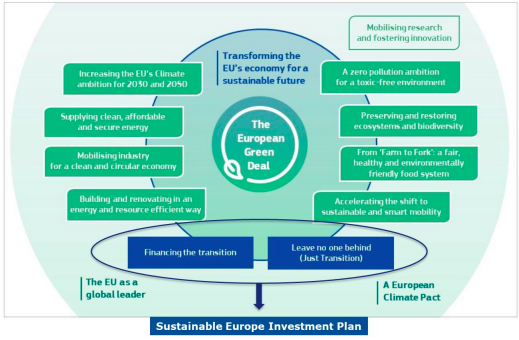Urban planning adapts to the needs of its times from industrial revolution to modernity; we have aimed to enhance development at an accelerated rate. We wanted more and bigger cities developed for cars and the ultimate technology. Facing the consequences of climate change, we now feel the urgency to understand our relationship with the materials and resources that make our societies work, which means slowing down our processes and building an innovative and conscious connection with the environment. But how can we continue an accelerated rate of living sustainably?
To transform growth dynamics at a medium-term, the European Commission implemented the European Green Deal as part of a plan to make the EU’s economy sustainable “by turning climate and environmental challenges into opportunities and making the transition just and inclusive for all. “(European Commission) The deal puts growth as a priority; the idea is for this new growth strategy to “give back more than it takes away.”

One of the Green Deal’s action plans is to “boost the efficient use of resources by moving to a clean, circular economy,”(European Commission) an action plan that primarily targets cities as regions that are both the producers of environmental footprints and spaces with the potential to develop a global sustainable development. According to the United Nations Environment Programme, cities play a leading role in implementing a Green New deal as today account for about 75% of the world’s CO2 emissions.
The Green New Deal has decided to bet for implementing a circular economy as it seems to be a responsible way forward to relate to our consumption and production habits, especially in cities. In a joint effort to reduce CO2 emissions, theorists, civil societies, NGOs, governments, and supra governmental institutions started adopting more circular measures.
Even if circularity is not a new term, it has popped up more and more in recent years. It forms part of a group of concepts such as resiliency, sustainability, and climate change that can transform the way we think about nature and resources as much as they can become buzzwords. Circularity refers to a transformation in how our societies relate to materials; the aim is to generate a cycle or value chain that prevents waste.
From self-destructive to self-sustaining
According to Francesca Zannotto, any production process and decision made brings waste as a consequence, “waste is a basic, unavoidable part of the metabolism of reality” (Zanotto,2020). Human needs at the pace our societies have reached consume a high volume of resources and produce lots of waste. As Zanotto describes, we face the contradiction of having waste at the center. Our everyday life consumption and domestic presence erode resources and leave debris.
Moving to a clean circular economy would mean to think clearly of the physical dimension of waste and resources while at the same time influence behaviors that foster circular practices. The Green New Deal plans to tackle the contradictions of waste vs. human existence by focusing on the circular economy, creating a synergy in which governance meets design and, most notably, urban design. The deal would bring changes not only to infrastructure but also to practice, but is this enough?
The circular economy action plan includes investment in environmentally-friendly technologies, supporting industry innovation, implementing cleaner, safer and healthier forms of transportation, decarbonizing energy, ensuring buildings are more energy-efficient and improving global environmental standards with international partners.
By principle, a circular economy aims to close loops, extend the life cycle of objects, and implement business models for circular and climate-neutral consumption. However, all this can be supported by creating thriving, resilient communities through new sharing, co-owning & managing cities’ resources. The transition to clean energies involves normative in creating products and their life-long cycles and people and their everyday life consumptions and practices.

The supranational focus on circular economies would validate efforts from civil society and governments to implement circular practices. However, as stated above, it remains primarily a task for cities and municipalities to think and implement circular practices. For instance, the Green City Accord is a policy initiative derived from the European Green Deal to fund the implementation of techniques for clean and healthy cities for Europe, with a €1.8 trillion package to put regions and cities at the core for a green, digital and resilient recovery.
The European Union’s efforts in a complex topic such as reducing carbon footprint have their caveats. There has been a proposal to think beyond the so-called technocratic approach to thinking of a Circular Society, not only a Circular Economy, meaning that the transformational change emphasizes the social perspective, addresses the long-needed systemic transformation, and reshapes the balance between techno-, eco-, and sociosphere. (Calisto, F. M, 2020) This approach thinks of a systemic change that implements self-sustaining dynamics to reach a mid-term scale transformative cycle.
Contemporary challenges have proven the importance of rethinking the growth pace that our societies have developed in recent years, especially in cities. To achieve that, efforts like Europe’s Green Deal propose a platform for design to meet policy, this might translate in an efficient way to redesign our relationship with waste and consumption through sustainable practices such as Circular Economy. Cities will be the main target for this transformation since they are both centers of hazard and opportunity, the next questions rely on how circularity can be part of not only the economy but also society and the city system as a whole, involving its citizens and their practices.
Sources:
A European Green Deal. Striving to be the first climate-neutral continent
https://ec.europa.eu/info/strategy/priorities-2019-2024/european-green-deal_en
Calisto, F. M., Vermeulen, W. J. V., & Salomone, R. (October 01, 2020). A typology of circular economy discourses: Navigating the diverse visions of a contested paradigm. Resources, Conservation & Recycling, 161.
EU Circular Economy Action Plan. A new Circular Economy Action Plan for a Cleaner and More Competitive Europe.
https://ec.europa.eu/environment/circular-economy/
Zanotto, F. (2020). Circular architecture: A design ideology. Siracusa: LetteraVentidue.
